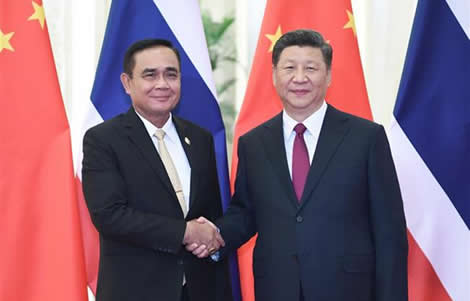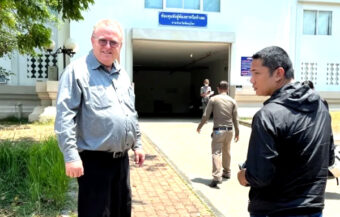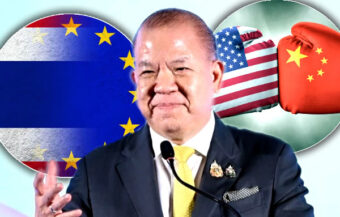The speech by the Thai Prime Minister went further than just trade and suggested a greater convergence between all the countries involved on regulation, the digital economy and even society. While the move positions Thailand more in China’s sphere of influence than before, it was an imperative given the need for Thailand to develop its economy as outlined in the governments adopted Thailand 4.0 plan which aims to move Thailand to a higher income economy. Given Thailand’s stated economic plan and the strategic location of the kingdom, it had to be part if this hugely ambitious Belt and Road plan. The next question is the cost and the rise in public borrowing it will bring about. Some experts say Thailand can afford it, others question the economic viability of the expensive high speed rail network. For Thailand’s economic team, the Chinese project is an opportunity that it feels it cannot afford to miss.
The participation of Thailand’s Prime Minister at the hugely successful Belt and Road summit outside Beijing this weekend marked a new commitment by Thailand to the programme as it signed up with 36 other nations to the pact. The initiative was praised by Prayut Chan ocha who said that the project offered guidance and leadership for the future. The move will see Thailand move forward with the second phase of the Bangkok to Nong Khai high speed rail link which will cost ฿211 billion and which is set to be finished by 2023. The participation of Thailand in the initiative reaffirms Thailand’s commitment to opening up the country to increased trade and positioning itself as a gateway between China and the Asean community. The move raises some concern about an increase in public borrowing to pay for the plan. It commits Thailand to a global vision of trade which it shares with China. The Thai leader also expressed a hope that the new initiative would see movement towards shared regulation, digital connectivity and society between all the nations involved.

Thai Prime Minister had a busy weekend at the international summit in China to discuss the huge Chinese Belt Road initiative. The Thai leader gave his strong backing to the plan and praised it as one that offers leadership to the world which it would need in years to come.
Chinese Belt Road initiative chimes with Asean
The PM said the plans offered greater connectivity for Thailand and was fully in keeping with the goals of the Asean community which he current chairs. Not only does the Chinese belt and road initiative offer vital physical connectivity to Thailand with high speed rail links and greater maritime access to Thailand’s ports, but it also paves the way for movement towards common regulation, digital connectivity and well as society as a whole.
Thailand reported to be taking up new loans
The decisive move this weekend comes at the same time as Thailand is believed to be on the verge of taking up large loan facilities to fund the huge new high speed train networks as part of a programme to transform Thailand’s infrastructure between now and 2025. Concerns have been expressed that Thailand may be taking on too much public debt. Some suggest that the new rail facilities are unlikely to be profitable initially.
Thai PM joins stunning array of powerful world leader at summit on outskirts of Beijing
The huge summit over the weekend was attended by a stunning array of world leaders including the Thai delegation led by the Prime Minister. However, notably absent was the United States which since 2017 has turned its face against the initiative to the point where it recently strongly criticised Italy, the first G7 nation and European Union state to sign up earlier this year. This will see large investment in Italian ports. Washington has described the Chinese initiative as a ‘vanity project’ and has issued warnings to countries about the possibility of a debt trap and the growing influence of China which it sees as less benign. It comes at a time when the US is involved in a trade war with the emerging superpower on Thailand’s door step, a struggle which is currently having a strong and negative impact on Thailand’s economy.
Chinese President struck a sincere note
At the summit over the weeknd, the Chinese President Xi Jinping struck a more comforting note. While speaking positively about trade negotiations with the United States, he assured his international audience that the Chinese initiative, his signature project as Chinese leader, was sincere and that great care would be taken to make sure that it as free from corruption, did not mire participating countries in debt and would be environmentally friendly. It was exactly what his audience, including UK Chancellor Philip Hammond, wanted to hear. A the summit, new countries came on board including Portugal, Austria, Switzerland the United Arab Emirates and of course, Thailand. This weekend, 37 countries joined as partners of the initiative in all following a commitment from 29 countries in 2017. In addition, 126 countries now as well as nearly 30 international organisations have given the project their imprimatur.
Huge success for Chinese diplomacy
The weekend summit in Beijing has been seen as a huge success for China and its foreign policy. It is seen as a challenge to the United States although the Chinese leader played down such an interpretation. Even Malaysia’s veteran prime minister who signaled the withdrawal of his country from key aspects of the plan when he came to power in May 2018, is now back on board after negotiating a 30% saving for his country. He was also present at the summit and gave the project his full support. The summit is reported by its Chinese organizers to have generated 283 ‘practical outcomes’ and seen $64 billion in deals made. The Chinese President promised that in the future, other countries also would come to see the plan in a positive light when they ‘finally realise that China is not as scary as they thought.’
Italian leader was at the summit as Italy became the first G7 member and European Union state to sign up to the Chinese plan for its ports
The summit even saw conservative Switzerland’s President, Ueli Maurer, sign off on the communique and heard from European countries already working within the belt road initiative, of positive outcomes. These included the Greek port of Piraeus which has zoomed up the tables in terms of freight handled through Chinese investment to a huge steel plant in Serbia, now a huge exporter for that country. The satisfaction of the Italians, anxious to chart a new economic course as discordance with the European Union grows in that country, was also on show. The summit saw negotiations and comprises struck with IMF leader Christine Lagarde who has expressed reservations about some aspects of the project, a sentiment shared by her compatriot, the French leader Emmanuel Macron as well as the European Union.
Belt and Road initiative opens the World up to China
The Belt and Road initiative is a gigantic project which aims at nothing less that the opening of the world to China. It seeks an improvement not only in connections but the speed and ease of transport between the huge country and every corner of the world.
Thai PM put forward Thailand’s goals to increase connectivity of the country within Asia
The goals of Thailand were outlined by the Prime Minister Prayut Chan ocha to world leaders at the summit. The Thai leader underlined the priority for Thailand of the 2025 Master Plan for Asean Connectivity and the Ayeyawady-Chao Phraya-Mekong Economic Cooperation Strategic Master Plan to improve regional communications between Myanmar, Thailand, Laos and China.
Thailand positions itself as the gateway from Asean to China as it seeks to leverage its location
The Thai prime minister emphasised Thailand’s 4.0 economic development plan and the Eastern Economic Corridor (EEC) which it is currently developing along its eastern provinces. Thailand’s goal is to position itself as a gateway for the Asean community to China. The Prime Minister, Prayut Chan ocha, had a meeting with the Chinese President, the powerful Chinese Premier Li Keqiang and Deputy Premier Han Zheng to discuss Chinese Thai bilateral relations and cooperation.
Russian president Vladimir Putin saw Chinese initiative as bulwark against protectionism
The summit saw a large number of international leaders attend. The Pakistani Prime Minister Imran Khan, the Russian President Vladimir Putin and the Italian Prime Minister Giuseppe Conte were notable attendees. The elephant in the room was US President Donald Trump and growing US opposition to the plan which is being more discreetly echoed also from some European capitals. The Russian president used the occasion to take a swipe at the US when he addressed the assembly to call for a global response against ‘protectionism’ and ‘trade wars’.
Key component of the initiative from Thailand is the new high speed rail plan to Nong Khai
With the talk over, we must examine the practical work to implement the plan in Thailand and the possible repercussions. Thailand has been vociferous in its determination to avoid indebtedness to Chinese lenders and to turn instead to domestic finance sources for its rail infrastructure projects as part of its contribution to the belt road initiative.
Thailand signs memo of understanding with China and Laos on high speed rail links
It is reported that Thailand intended to sign an understanding with China and Laos at the weekend summit. The country has already begun construction of the high speed rail initiative in the north eastern provinces of Thailand which will link up with Laos and provide high speed access to that area through to China.
Loan offers from the Export Import Bank of Thailand to Thailand at better interest rates
It was mooted in January that a new loan offer had been made by the Export Import Bank of China to Thailand at a loan rate of 2.3%. This was a significant reduction from an earlier offer of a rate of 2.86%. There is speculation that a loan package is being finalised for Thailand to fund the new infrastructure projects.
฿390 billion cost between now and 2023 for 608 km of high speed rail from Bangkok to Nong Khai
The cost of these projects between now and 2025 will be extremely high. The first phase of the Bangkok to Nong Khai high speed rail route, which will run to Nakhon Ratchasima, a distance of 253 km, is projected to cost ฿179 billion. Thailand’s finance ministry has suggested that loans for the project are provided for in Thai baht. It has also confirmed that the Thai government has successfully resisted Chinese efforts for influence and commercial concessions in relation to the projects. The involvement of Chinese companies and personnel is strictly limited to training the Thai personnel who will operate the new system. The second phase of the rail project, which will see the line extended by 355 km from Nakhon Ratchasima to Nong Khai, will come in at a cost ฿211 billion. The project is 85% financed, according to Thai officials, by international loans. The total cost of the project is ฿390 billion. The full rail service is expected to be up and running by 2023.
Concerns raised about high levels of new public debt to be incurred by Thailand
At a time when the Thai economy may be facing a down turn, there are concerns about the rise in public debt being taken on to fund these projects and other initiatives which the Thai government is planning in order to bring about its new economic vision for the country. In it defence, the current problem is due to an international down turn driven by protectionism and Thai authorities now seem to be making a clear decision to develop the country and seek more outward trade at every opportunity. The goal of turning Thailand into a transit and manufacturing hub must require funding and action.
Sea links to link Laem Chabang and the eastern economic corridor to Chinese network
A key part of the plan is also the development of the Thailand’s deep sea port at Laem Chabang and the linking of the belt and road network with the Eastern Economic Corridor in Thailand’s eastern provinces. The Belt Road initiative will effectively link the South China Sea with the Andaman Sea. For Thai leaders, the opportunity of the Chinese belt road is too good to pass on if they are serious about their economic agenda. Another consideration is the benefit, in the short term, of infrastructure expenditure to economic growth which is recommended by many economists. The issue is what the return will be or the financial viability of the massive investment required.
Divided opinions on the value and efficacy of the proposed new rail network to China
There are divided opinions. Many suggest that the new rail system will find it difficult to become profitable. There is also concern that the route proposed does not match existing population centres or manufacturing hubs. The project, of course, ultimately may either spell change or failure. The experience of Sri Lanka in its relationship with China should be a cautionary tale. That country has had mixed success with infrastructure projects funded by Chinese loans. Some have proved boons but others are white elephants. The problem now for Sri Lanka is that it is facing huge difficulties repaying a $5.9 billion or ฿189 billion due at this time in loan repayments to its Chinese creditors.
Sri Lanka should be a cautionary tale for Thailand and new Chinese led spending plans
The experience of Sri Lanka has been pointed to by critics such as the United States or even the mildly skeptical or lukewarm such India and even Japan as the reality of what may transpire with the Chinese Belt and Road project in operation. Detractors suggest that Chinese influence over Sri Lanka’s economic decisions and future has grown. While Thailand is a substantially bigger economy and claims to have better recourse to international finance, there is no doubt that Thailand’s full participation in the Chinese project will have consequences whether things go right or wrong.
Analyst feels Thailand is a large enough economy and its financial situation is sound enough to be able to undertake the high speed rail project
Siwat Luangsomboon is an economic analyst at Kasikorn Research Centre. He feels Thailand can avoid the danger of falling into a perilous debt trap. He believes that Thailand can find a range of lending options unlike smaller economies who have become part of the Chinese initiative. He also points to the careful management of Thailand’s finances to date and suggests that the borrowing proposed is not out of line with the country’s resources and the size of its economy. The Thai economy was worth $455 billion in 2017 compared to $87 for Sri Lanka based on 2017 values.
Transport expert warns of duplication of infrastructural projects and questions viability
Surachet Pravinvongvuth is a transport expert. In an interview with the Bangkok Post this week, he expressed doubts on the viability of the expensive new rail networks being proposed. He also pointed out that there is already duplication between the proposed new routes and large motorway projects already approved by the Thai government. This will further dilute any income potential for the high speed rail network.
Summit may indicate turning point for Thailand’s relationship with China, its ‘No 1 partner’
It is clear that this weekend’s summit could be a turning point for Thailand’s economic development and its relationship with China. The policy being pursued by Thailand and its prime minister who currently chairs the Asean community is clear. In a July 2018 wide ranging interview with Time magazine, the Prime Minister, Prayut Chan ocha clearly identified China as Thailand’s ‘No 1 partner’ and pointed to a relationship that has existed for thousands of years. The relationship with the United States, he suggested, has existed for just over two hundred years. The Prime Minister emphasized that Thailand was a small enough nation which wanted to be friendly with all countries.
Chinese is still a country controlled by the Communist Party but its reforms since 1979 have seen the greatest rise in prosperity in history
The recent history between the countries is really just over a hundred years old since the Chinese empire collapsed in 1912 and modern China emerged. China is still a country controlled by the Communist Party and Thailand, in the latter half of the twentieth century, was a staunch US ally resisting the advances of communism. Today, China has embraced a capitalist model when it comes to markets within its own country since 1979 but still retains crucial economic controls and levers not least since the Communist Party controls the entire state apparatus. There are also strong concerns about human rights in China across a range of issues. It is not a democratic country. China’s economic reforms only took place within the last forty years but the effects have been truly revolutionary. It is a policy that has had huge success in fighting poverty in China and is perhaps the greatest success the world has ever recorded in lifting so many people, in such a short time, to prosperity. It has also changed the world outside of China in which it has now come to be seen as the engine if not the champion of globalism.
The world has changed and there is now a new political axis between globalism and sovereignty
This new changed world today has also begun to revolve on a new political axis. It is no longer about left and right anymore in terms of policies and political differences. The new political debate worldwide is now more about national identity and control versus a more global order. The new American policy championed by US President Donald Trump, promotes instead the concept of competition between nations and states as opposed to co-operation. The new populist movement emphasises sovereignty and the sovereignty of the people. What is driving US policy and a growing movement towards populism in Europe and elsewhere is less of an emphasis on economic development and international cooperation driven by large corporate entities and a move towards the rights of the voting public at grass roots level to control the activities of government including economic policy.
Accepted economic wisdom of the past 70 years is being challenged in western nations
The accepted wisdom in the last seventy years has been that globalism and the opening up of international trade is the key to prosperity. This wisdom is now being challenged in many western countries and societies on the basis of the power and real prosperity it brings to the individual worker or democratic voter. It is a debate akin to the business theory one hundred years ago which suggested that bigger firms were inherently more competitive because of scale. This was later challenged when smaller firms were found to be more innovative in many areas. It would be wise not to dismiss the populist movement in western countries as simply backward and misguided while always being acutely aware of the dangers of virulent nationalism.
Thai Prime Minister appears committed to Asean and opening up Thailand and Asia to unlock prosperity
Thailand’s current leader is clearly prioritising a more open economic vision. It is a policy of promoting the Asean community and opening up the economic potential of Asia to bring prosperity to all countries in the region including the people living with them. Due to its strategic position, Thailand cannot simply ignore the gargantuan Chinese initiative. However, this puts it at the center of what is increasingly looking like a struggle between the two superpowers and blocs. While this weekend shows it firmly working with China and in its role as Asean leader, Thailand will also have to look carefully at its relationship with the United States and such countries as Japan which is a huge investor in Thailand. Japan, while being supportive of the Chinese initiative, is also looking at bolstering its own role in assisting middle income countries like Thailand develop with what it calls ‘quality’ infrastructure.


















